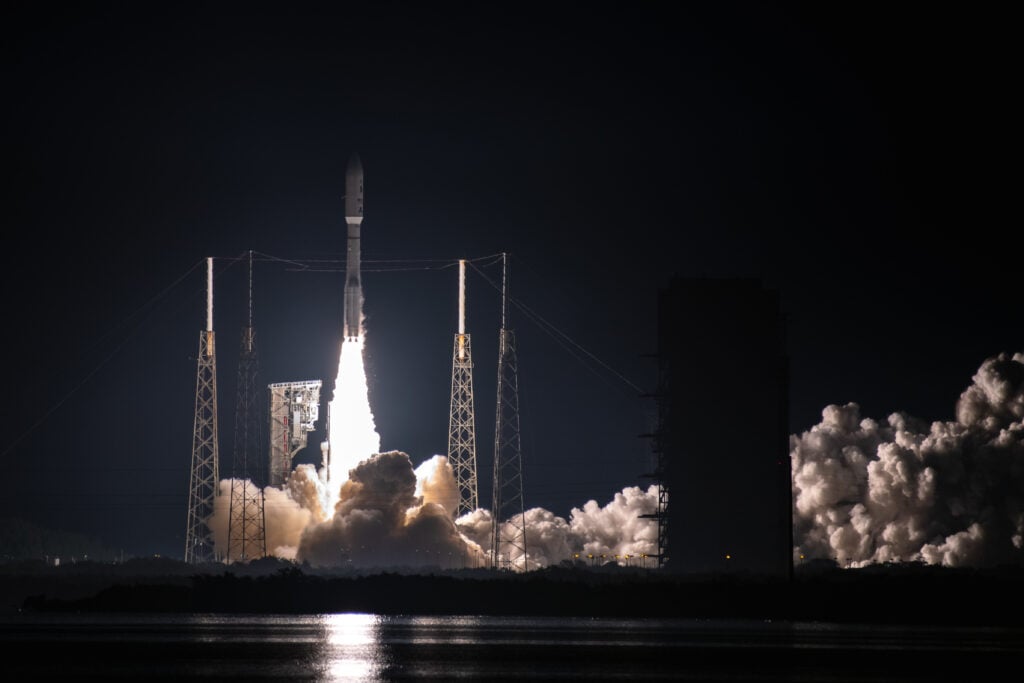
A United Launch Alliance Atlas V rocket lifts off Dec. 7, 2021, from Space Launch Complex 41 at Cape Canaveral Space Force Station, Fla. The rocket propelled two Department of Defense Space Test Program satellites into space. (US Space Force photo by Joshua Conti)
WASHINGTON — The Defense Department’s Space Test Program (STP) is setting up a system to buy commercial satellite buses capable of carrying multiple experiments to orbit, with an eye on choosing the first vendors in December.
The effort, called Space Test Experiments Platform 2.0 (STEP 2.0), aims to create a consortium of providers who have flight-proven buses via an indefinite delivery/indefinite quality (ID/IQ) contract, Lt. Col. Jonathan Shea, STP director, said Monday.
The program is looking to include “as many folks as possible” in that consortium, he told reporters in a roundtable briefing. “The … idea is that we’re going to try to do ‘buy what we can,’ not modify” — referencing the motto of Space Systems Command head Lt. Gen. Michael Guetlein: “Exploit what we have, buy what we can and build what we must.”
In particular, he and other DoD officials explained, the STEP 2.0 program is looking at commercial buses that can carry many experimental payloads at the same time to accommodate the fact that space systems are getting smaller, and many emerging capabilities are based largely on software, not large hardware, systems.
“We’ve noticed a trend over the last couple of years, wherein we used to get full satellites, but as technology has been more and more miniaturized what we get … is a lot more just experiments on their own that are needing the care, feeding and basically life components from a bus.”
Through the STEP 2.0 program, he explained, “we’ll be able to get more of our non-free-flying experiments bundled together for efficiency.”
Currently, Shea said, his team foresees a first order under the ID/IQ contract vehicle in the “early part of 2024, for STP Satellite 8,” which is expected to be a moderately sized CubeSat (12U) with two experiments on board. That satellite is now roughly planned for launch sometime in the early 2025 timeframe, he said.
The STP office is working in tandem with Space Systems Command’s Rocket Systems Launch Program, which buys launch services for small satellites.
Space Systems Command, which is the Space Force’s primary acquisition command, on Monday announced that it has issued a draft request for proposals [PDF] and is seeking industry response to develop a formal solicitation. The specifics, however, are “controlled” information and only available to US owned companies.
“STEP 2.0 aims to advance the United States Space Force’s (USSF) Science and Technology (S&T) enterprise by procuring commercially developed spacecraft with demonstrated flight heritage to host DoD-sponsored payloads over the next 10 years,” the release says. “By leveraging commercially developed spacecraft and partnering with industry stakeholders, the STEP 2.0 program aims to reduce costs, streamline processes, and accelerate the development of cutting-edge space technologies for the joint warfighter.”
Space Systems Command manages the DoD STP program, which according to a fact sheet written by Shea “provides mission design, spacecraft acquisition, integration, launch and operations support to facilitate experimental payload access to the space domain.”
STP works with other government agencies, such as NASA, as well as with industry and academia to demonstrate on orbit new tech that shows promise — systems that are at “technology readiness level number six,” which essentially means at the fully functional prototype phase, Col. Eric Nelson, director of the Capability Delivery Directorate at the office of Assistant Secretary of the Air Force for Space Acquisition & Integration, told reporters during the briefing.
Decisions about what experiments the STP office flies are made by the Space Experiments Review Board, which is made up of representatives of the Office of the Secretary of Defense, the Army, Navy, Air Force, Defense Advanced Research Projects Agency (DARPA), the NASA, National Reconnaissance Office (NRO), and the Missile Defense Agency (MDA).
“This year, we’ll consider over over 60 experiments to include governments and from academia and then private industry as well,” said Nelson.
Shea explained that the board approves the experiments and gives them a rank, and then the STP office tries to “matchmake” each one with available satellite buses and launch vehicles. But given the small size of the budget, and the uncertainty in availability of buses and rockets, he said, the average number of experiments that make it to orbit per year is between 10 and 15.
The Space Force asked for $30 million for STP in its fiscal 2024 budget request, up slightly from the $25 million appropriated for the program in FY23.
HASC chair backs Air Force plan on space Guard units (Exclusive)
House Armed Services Chairman Mike Rogers tells Breaking Defense that Guard advocates should not “waste their time” lobbying against the move.



























